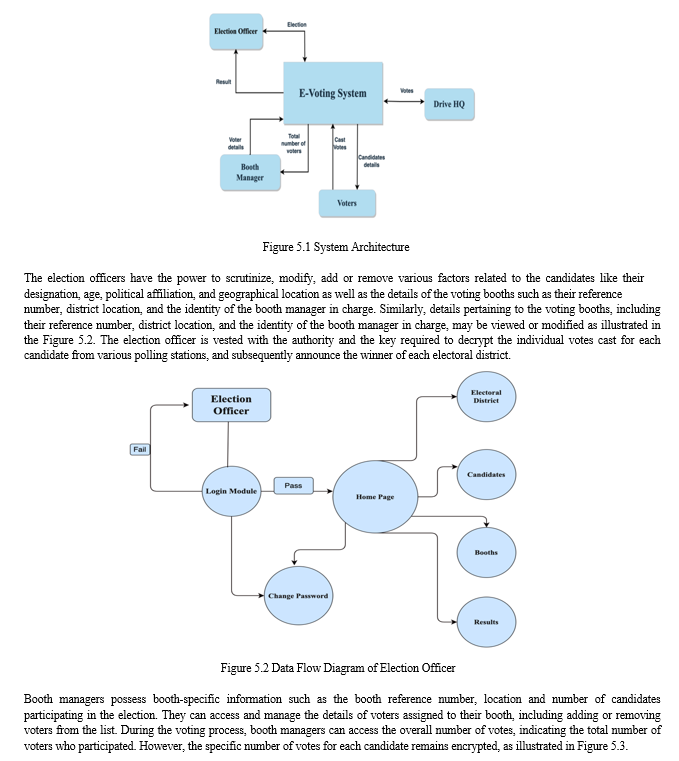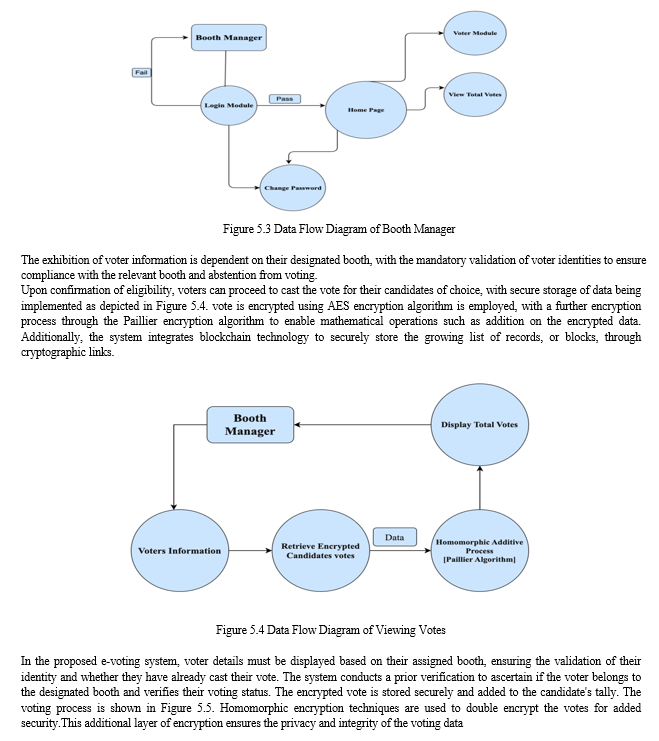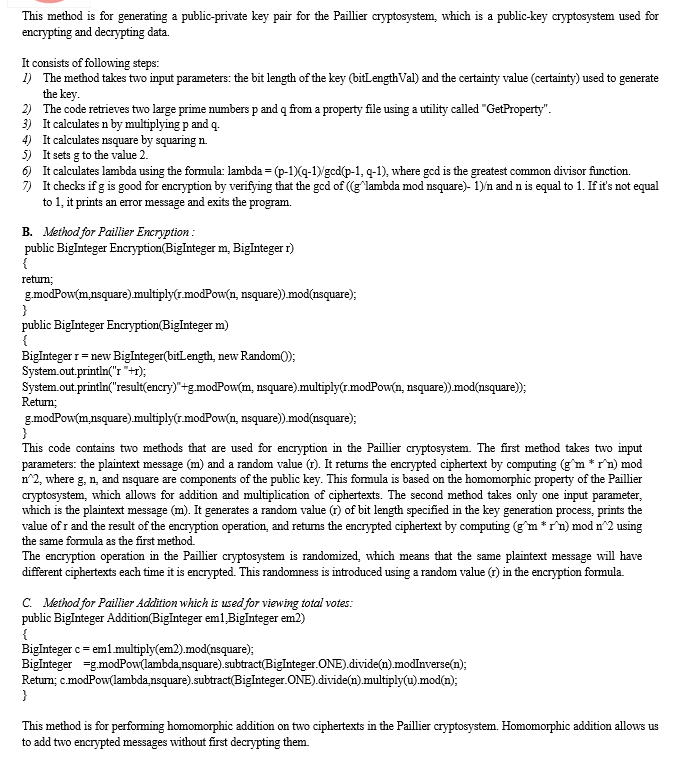Ijraset Journal For Research in Applied Science and Engineering Technology
- Home / Ijraset
- On This Page
- Abstract
- Introduction
- Conclusion
- References
- Copyright
E-Voting System using Blockchain Technology and Homomorphic Encryption
Authors: Danush Kanchi, Hitesh N, Kushal A C, Yuvan Yash, Dr. C S Jayasheela
DOI Link: https://doi.org/10.22214/ijraset.2023.54573
Certificate: View Certificate
Abstract
Voting is an essential component of any democratic society but traditional systems often face obstacles like inefficiency, human error, and transparency issues thus hindering credibility. This inspired our aim to create a proof-of-concept for an e-voting system that leverages blockchain technology coupled with homomorphic encryption as means to address these impediments. In doing so, the proposed system intends to restore trust in electoral processes by improving their transparency, integrity, and efficiency. Blockchain technology provides a verifiable account and a convenient database, culminating in the smooth conduct of elections for the general public, and fostering confidence in the precision of the outcomes obtained. Homomorphic encryption secures votes utilizing encrypted data computations allaying public concerns on voter anonymity. It also affords utmost privacy security of individual votes inevitably cutting costs since elections no longer require physical ballots or polling booths.
Introduction
I. INTRODUCTION
Voting is the backbone of democracy and forms the basis on which the governance of a country rests. With the advent of technology and the increasing impact of digitalization on the youth of the country, it has become imperative to modernize the traditional voting process. The current electoral procedure has encountered a multitude of discrepancies, and it is imperative to implement technological advancements to amend the current process. Traditional voting systems, such as paper-based ballots, are prone to human errors and can be time-consuming. Electronic voting has gained attention due to its potential to reduce costs and ensure the integrity of the electoral process through privacy, security, and compliance requirements. The manual counting of ballots can be cumbersome and can lead to errors, which can affect the outcome of an election. Electronic voting systems offer a more efficient and accurate way of casting and counting votes, which can reduce the likelihood of errors and enhance the transparency of the electoral process. However, the current method of electronic voting has been proven to be unsatisfactory with respect to transparency. In addition, the deficiency of any external influence with regard to the government's execution of the vote recounting process presents a challenge in guaranteeing the authenticity of the electoral process for the voters. Blockchain technology offers a promising solution to the transparency problem in electronic voting. The utilisation of blockchain technology has the potential to furnish a lucid and verifiable documentation of the electoral process, thereby augmenting the probity and credibility of the said process. The adoption of blockchain-based electronic voting systems can ensure that voters are assured of the integrity of the electoral process and can lead to a more transparent and trustworthy democratic process. Homomorphic encryption is a cryptographic methodology that can execute computations on encrypted data without requiring decryption. It is particularly relevant in electronic voting (e-voting) technology, where privacy and security are critical. In e-voting systems that utilize blockchain technology, homomorphic encryption can be employed to ensure the confidentiality of votes while maintaining the ability to perform certain computations on the encrypted data. The combination of homomorphic encryption and blockchain technology can establish a secure and open platform for electronic voting systems to execute electoral processes.
II. RELATED WORK
Siddharth Rajput et al. [1] emphasize the significance of a decentralized and transparent record-keeping mechanism that is shared among various participants. It ensures that every transaction undergoes verification by all parties involved. Once data is recorded in the blockchain, it becomes immutable and hence, resistant to alteration. Therefore, the blockchain serves as a comprehensive transaction ledger. The review covers topics such as smart contracts, consensus algorithms, and scalability challenges encountered in blockchain networks.
Nazmun Nahar et al. [2] highlights there has been a significant surge in the demand for blockchain technology across various sectors and fields. Blockchain functions as a shared digital database within a computer network. In the context of decentralized cloud storage, data undergoes encryption using cryptographic algorithms and a user's private key. Implementing blockchain for data storage enhances system security, reduces the risk of attacks, and eliminates single points of failure.
Jilles Hasenberg et al. [3] make a valuable contribution to the discourse on electronic voting, which is often touted as a more secure option than traditional voting systems, thereby instilling greater confidence and transparency among the populace. However, several challenges exist in managing electronic voting procedures. Homomorphic encryption, a cryptographic algorithm, is foundational to many schemes utilized in electronic voting. These schemes utilize homomorphic properties and offer different encryption implementations for analysing and applying them in the context of electronic voting. Through deductive methodology, logical analytics, and exploratory research, three homomorphic encryption schemes are described and evaluated. These schemes, while employing different algorithms, maintain efficiency and do not compromise security. Furthermore, the significance of a distributed architecture is emphasized as an additional measure for handling election information. The use of homomorphic encryption in electronic voting ensures secure computation on encrypted data while preserving voter privacy.
Divya Rathore et al. [4] have developed a remote internet- based voting system that permits voters to participate in the electoral process from the comfort of their homes, without the need for a physical invigilator. The system leverages blockchain technology and a cryptosystem to guarantee the dependability, security, and anonymity of both the voters and their votes. Moreover, it prevents the prediction of the winning party until the results are announced, thereby enhancing citizen trust through transparency and improved voting system security. Ongoing research in this field aims to merge legal and technical aspects to create a self-sustaining proofreading system in various digital services.
Mingli Zhang et al. [5] have noted that authentication mechanisms based on trusted authorities are frequently employed in traditional systems. Although such mechanisms have proved effective, their security may not meet the demands of modern technologies. The blockchain is a centralised mechanism that requires a trusted authority for trust. The use of data encryption, timestamping, and consensus mechanisms facilitates this process. The OTP scheme is utilized within the blockchain as the OTP verifier. The security of the authentication protocol proposed is evaluated using a set of security criteria. The scheme effectively resists replay attacks, brute force attacks, and OTP forgery attacks. A comparative assessment of the proposed OTP scheme and other representative OTP schemes is conducted using designated evaluation criteria. It has been proven that the recommended plan is better than others in terms of both performance and security, as seen in the comparative experiments run on Hyperledger Fabric.
III. PROBLEM DEFINITION
The current method of physical voting is susceptible to manipulation, requires significant manual labour, and presents challenges for individuals with disabilities. This paper endeavours to address the aforementioned concerns by developing an electronic voting mechanism that incorporates blockchain technology and homomorphic encryption. The aim is to facilitate eligible voters in securely casting their votes from their computers while ensuring the transparency, integrity, and immutability of the voting process.
Through the elimination of physical ballot papers and polling booths, the proposed system seeks to improve efficiency and cost-effectiveness, all while ensuring a secure and accurate method for voters to participate in elections.
IV. OBJECTIVES
- Develop a tamper-proof E-voting system utilizing Blockchain technology and AES with Homomorphic encryption.
- Enable eligible voters to cast their ballots using their computers by employing a one-time password sent to their verified email ID and SMS.
- Ensure the integrity and transparency of the voting process by securely recording all transactions in an immutable manner.
- Improve efficiency and cost-effectiveness of the voting process by eliminating the requirement for physical ballot papers and polling booths.
- Propose a secure, transparent, and precise system that enables voters to cast their votes while upholding the integrity of the entire election process.
V. SYSTEM ARCHITECTURE
The proposed architectural framework, as presented in Figure 5.1, comprises three indispensable modules, namely, the Election Officer, the Booth Manager, and the Voters. The Election Officer module bears the responsibility of integrating candidate details, administering booth managers, allocating booths, and validating the election outcomes. The Booth Manager module is entrusted with the task of authenticating voter information during the voting procedure. Voters are assigned a specific identification number that authorizes them to log in to the voting system using a One Time Password (OTP) and vote for their preferred candidate.




It consists of the following steps:
- The method takes two input parameters: the ciphertexts to be added (em1 and em2).
- It computes the product of the two ciphertexts (em1 * em2) modulo nsquare, where nsquare is the square of n (which is a component of the public key).
- It computes u, which is equal to (g^lambda mod nsquare - 1)/n, where lambda is a component of the private key.
- It computes the decryption factor for the sum of the ciphertexts by computing c^lambda mod nsquare - 1 / n, where c is the product of the two ciphertexts calculated in step 2. It multiplies the decryption factor with u, and takes the result modulo n, to obtain the final sum of the plaintext messages encrypted in the two ciphertexts.
The addition operation in the Paillier cryptosystem is homomorphic, which means that the sum of two encrypted messages is also an encrypted message. This method is used to display the total votes casted in a particular booth to the corresponding Booth Manager.
D. Method for Paillier Decryption
public BigInteger Decryption(BigInteger c) {
BigInteger u
=g.modPow(lambda,nsquare).subtract(BigInteger.ONE).divide(n).modInverse(n);
Return;
c.modPow(lambda,nsquare).subtract(BigInteger.ONE).divide(n).multiply(u).mod(n);
}
This method is for decrypting a ciphertext in the Paillier cryptosystem. The decryption process takes a ciphertext c as input and returns the decrypted plaintext message.
It consists of the following steps:
- The method first computes u, which is equal to (g^lambda mod nsquare - 1)/n, where lambda is a component of the private key and n and nsquare are components of the public key.
- It then computes the decryption factor for the ciphertext c by computing c^lambda mod nsquare - 1 / n.
- It multiplies the decryption factor with u, and takes the result modulo n, to obtain the decrypted plaintext message. Formula used in this code to decrypt a ciphertext is based on the properties of the Paillier cryptosystem, which allows for the decryption of a ciphertext without revealing the private key.
VII. IMPLEMENTATION
The use of blockchain technology, Advanced Encryption Standard (AES), and homomorphic encryption in the implementation of an electronic voting (e-voting) system delivers a secure and transparent platform for the conduct of elections. This guarantees the integrity of the voting process while simultaneously preserving the privacy of the voters. The basic foundation of this design hinges on the incorporation of blockchain technology, which operates as a persistent and decentralized record consisting of a series of blocks. Each block contains an encrypted vote set, ensuring that once a vote is registered on the blockchain, it remains unmodifiable and impervious to tampering, thereby upholding the integrity of the election outcomes. The integration of Advanced Encryption Standard (AES) encryption into the ballot provides an additional layer of security, making it difficult for unauthorized entities to tamper with or access vote data. AES, being a resilient encryption algorithm, is employed to guarantee the secrecy and accuracy of the vote. Through the application of AES encryption to the ballot, the system incorporates an additional layer of security, rendering it arduous for unauthorized entities to manipulate or obtain access to the vote data.
The utilisation of homomorphic encryption serves to preserve voter confidentiality by allowing mathematical operations to be executed on encrypted data without the need for decryption. This cryptographic technique facilitates mathematical operations to be performed on encrypted data sans the prerequisite of decryption.When applied to the context of an e-voting system, this characteristic permits the amalgamation of encrypted votes on the blockchain while upholding the secrecy of personal votes. The encrypted vote, which utilizes a combination of AES and homomorphic encryption, is subsequently transformed into a block. This strategy provides an assurance that the votes will be kept confidential and safe, since the voters' actual preferences are not exposed. The commencement of the electoral process involves the initiation of the election by an Election officer, thereby granting eligible voters access to the system's voting interface. The legitimacy of voters is verified by utilizing an authentication process that incorporates a One-Time Password (OTP) mechanism. Upon successfully accessing the voting interface, the voters are prompted to provide their credentials, which typically comprise a unique identification number.
Subsequently, the system ascertains the authenticity of these initial credentials and proceeds to generate a distinctive OTP, which is transmitted to the registered mobile number and email address linked with the voter. This verification process ensures that only individuals possessing valid credentials and access to the registered contact information are eligible to proceed with voting.
The voter receives the OTP on their mobile device and in their email inbox, subsequently inserting it into the specified field within the voting interface. The system then verifies the entered
OTP by comparing it against the OTP generated and sent earlier. The voter is authorized to vote if the OTPs match, indicating a successful authentication process.
Booth managers play a crucial role in managing the voting process. Their responsibility encompasses the addition of voters to their respective booths, as well as the ability to monitor the total votes cast within their designated areas, as depicted in Figure 7.1. This empowers them to ensure that the voting process is conducted with the utmost accuracy and legitimacy. However, due to the encryption and privacy-preserving nature of the system, booth managers are not privy to specific vote details or knowledge of which candidate garnered more votes.


Conclusion
This advanced approach instils trust and confidence in the electoral process, mitigating concerns regarding tampering and violations of privacy. Through the amalgamation of these technologies, a sturdy and impermeable environment is established, which guarantees the integrity, authenticity, and confidentiality of electoral outcomes. This advanced approach instils trust and confidence in the electoral process, thereby mitigating concerns regarding tampering and violations of privacy. The combination of blockchain technology and homomorphic encryption allows for a secure and private analysis of results while simultaneously maintaining voter privacy and system transparency. Statistical calculations can be performed with precision without revealing individual voting preferences. The combination of AES, homomorphic encryption, and blockchain technology in e-voting systems establishes a robust and impenetrable environment, which guarantees the confidentiality, authenticity, and integrity of electoral outcomes, thereby instilling trust and confidence in the electoral process. Despite the barriers, the ongoing creation and enhancement of scalable and secure implementations will have a meaningful impact on the widespread adoption of blockchain-based e-voting systems, thereby fostering trust, integrity, and impartiality in democratic processes.
References
[1] “Blockchain Technology and Cryptocurrencies” by Siddharth Rajput, Archana Singh, Smiti Khurana, Tushar Bansal, Sanyukta Shreshtha IEEE 2019 [2] “Application of Blockchain for the Security of Decentralized Cloud Computing” by Nazmun Nahar, Farah Hasin and Kazi Abu Taher IEEE 2021 [3] “A Homomorphic Encryption Approach in a Voting System in a Distributed Architecture” by Segundo Moisés Toapanta Toapanta , Luis José Chávez Chalén , Javier Gonzalo Ortiz Rojas , Luis Enrique Mafla Gallegos 2020 IEEE [4] “Secure Remote E-Voting using Blockchain” by Divya Rathore, Virender Ranga IEEE 2021 [5] “A Blockchain-Based Authentication Method with One-Time Password” by Mingli Zhang, Liming Wang, Jing Yang IEEE 2019
Copyright
Copyright © 2023 Danush Kanchi, Hitesh N, Kushal A C, Yuvan Yash, Dr. C S Jayasheela. This is an open access article distributed under the Creative Commons Attribution License, which permits unrestricted use, distribution, and reproduction in any medium, provided the original work is properly cited.

Download Paper
Paper Id : IJRASET54573
Publish Date : 2023-07-01
ISSN : 2321-9653
Publisher Name : IJRASET
DOI Link : Click Here
 Submit Paper Online
Submit Paper Online

